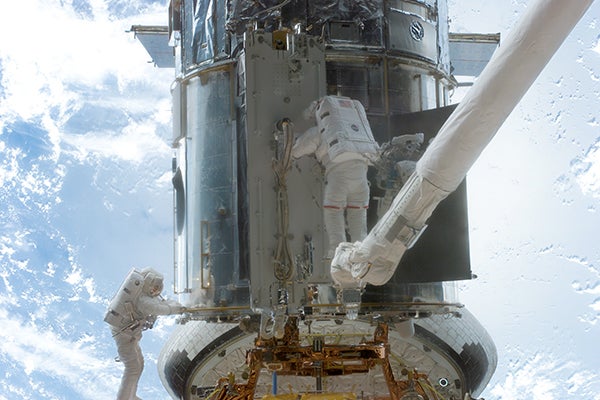The space shuttle Atlantis STS-125 mission is scheduled to launch May 11 in the fifth and final service call on the Hubble Space Telescope (HST). Powerful new scientific instruments, repairs to existing equipment, and a slate of parts replacements and enhancements will keep the orbiting observatory functioning at least into 2014.
The 11-day flight includes five spacewalks. Veteran astronaut Scott Altman will command STS-125. Retired Navy Capt. Gregory C. Johnson will pilot Atlantis. The five mission specialists on the crew are experienced spacewalkers John Grunsfeld and Mike Massimino. STS-125 will be the first flight in space for mission specialists Andrew Feustel, Michael Good, and Megan McArthur.
Astronomers have high hopes for the new instruments — the Wide Field Camera 3 (WFC3) and the Cosmic Origins Spectrograph (COS). “The biggest excitement revolves around the two new instruments,” said Richard Talcott, a senior editor at Astronomy.
The COS will devote most of its time to studying the large-scale structure of the universe and learning how galaxies, stars, and planets formed and evolved. (The instrument breaks down incoming light into its constituent wavelengths to study the temperature, density, composition, and motions of celestial objects.) The second new instrument, WFC3, will help researchers study galaxy evolution across the universe.
If the astronauts complete their extended to-do list, scientists will enjoy a big boost in their ability to study the universe. This includes studies of dark energy, the mysterious quantity that drives the universe’s accelerating expansion.
“If Hubble’s history is any indication, some of the greatest discoveries may lie ahead and be totally unanticipated,” Talcott said.
Past servicing missions
Servicing Mission 1 (December 1993): Endeavour astronauts installed the Wide Field and Planetary Camera 2 and the Corrective Optics Space Telescope Axial Replacement. The latter instrument corrected Hubble’s fuzzy vision, created by an incorrectly shaped primary mirror.
Servicing Mission 2 (February 1997): Discovery astronauts installed the Near Infrared Camera and Multi-Object Spectrograph and the Space Telescope Imaging Spectrograph.
Servicing Mission 3A (December 1999): NASA split Servicing Mission 3 into two parts. This Discovery mission was pushed up to perform needed maintenance (installing new gyroscopes was the key); no science instruments were changed.
Servicing Mission 3B (March 2002): Columbia astronauts installed the Advanced Camera for Surveys and a new cooling system for the Near Infrared Camera and Multi-Object Spectrograph.
Mission links













